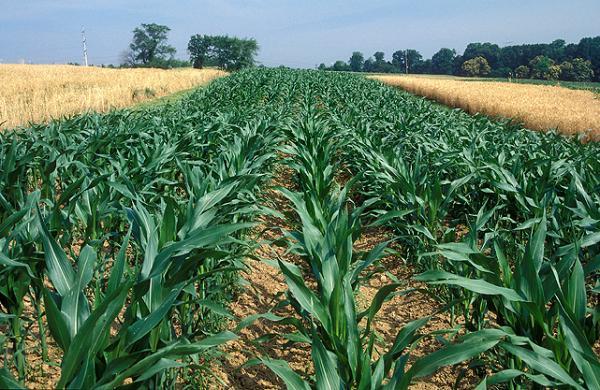
Agricultural News
Iowa State Study Raises Doubt on EPA Land Use Models
Mon, 17 Nov 2014 10:40:46 CST

A comprehensive analysis of real-world land use data released Friday by Iowa State University raises serious doubts and concerns about the reliability and accuracy of economic models used by regulatory agencies to penalize ethanol for purported "indirect land use changes," or ILUC. The new report found that farmers around the world have responded to higher crop prices in the past decade mainly by using existing land resources more efficiently not by converting forest and grassland into cropland.
The study, conducted by Prof. Bruce Babcock and Zabid Iqbal at ISU's Center for Agricultural and Rural Development (CARD), examined actual observed global land use changes in the period spanning from 2004 to 2012. The real-world data was analyzed and compared to predictions from the economic models used by the California Air Resources Board (CARB) and Environmental Protection Agency (EPA) to develop ILUC penalty factors for regulated biofuels.
According to the paper, "-the primary land use change response of the world's farmers in the last 10 years has been to use available land resources more efficiently rather than to expand the amount of land brought into production. This finding is not new. -But this finding has not been recognized by regulators who calculate indirect land use."
"This study should serve as a badly needed reality check for CARB, EPA, and regulators in Oregon and Washington who are implementing low carbon fuels policies," said RFA President and CEO Bob Dinneen. "There is simply no defensible science or empirical evidence to support the continued penalization of ethanol and other biofuels for purported ILUC emissions. Favoring the results of flawed and arcane computer models over real-world observations is just bad public policy. It is time to set the models aside and take a hard look at what has actually been happening with land use in the real world."
Dinneen continued, "Nearly seven years have come and gone since Timothy Searchinger's erroneous article in Science magazine introduced the ILUC theory. Now, we have the benefit of hindsight and it shows that increased crop production has been accommodated through more effective use of the existing agricultural land base, not through slashing forests and churning up native grassland as pre-supposed by Searchinger, CARB, and EPA. The doomsday predictions from their models were just plain wrong."
The authors refer to more efficient use of existing agricultural land resources as "intensive change," while conversion of non-agricultural land (e.g., grassland or forest) to cropland is called "extensive change." The study found that outside of Africa, "-the aggregate intensive change in land use was almost 15 times as large as extensive changes. This wide disparity between more intensive use of land and more extensive use means that the reliability of current models used to estimate indirect would be dramatically increased if they were modified to account for non-yield intensification of land use."
The more efficient land use practices examined include growing multiple crops on the same land in a single year (double- or triple-cropping), increasing the amount of planted cropland that is harvested, and reducing fallow (idle) cropland and temporary pasture. The economic models used by CARB and EPA have been unable to account for these efficiencies and their impacts on land use change emissions. Importantly, higher crop yields were not included in the ISU study's methodology, meaning the results likely understate the gains in land use efficiency witnessed over the past decade.
Ignoring the more efficient use of existing cropland means both the CARB and EPA models overstate conversion of non-agricultural lands, according to the report: "The pattern of recent land use changes suggests that existing estimates of greenhouse gas emissions caused by land conversions due to biofuel production are too high because they are based on models that do not allow for increases in non-yield intensification of land use. Intensification of land use does not involve clearing forests or plowing up native grasslands that lead to large losses of carbon stocks."
Other key findings from the study include:
-- A number of key crop-producing countries and regions including the European Union, Canada, United States, Russia, China, India, and Ukraine had "negligible or negative" cropland expansion during the past decade, and thus "should be presumed to not have converted pasture or forest to crops in response to biofuel-induced higher prices."
-- "-the only net contributor to US cropland from 2007 to 2010 was a reduction in CRP (Conservation Reserve Program) land. There was no net increase in cropland from conversion of forests, from conversion of urban land, or from conversion of pasture."
-- Nearly half of the emissions charged to corn ethanol by CARB's GTAP model result from predicted conversion of U.S. forestland, but the real-world data did not reveal such conversions ever occurred. "-GTAP estimates that conversion of US forests contributes 43% of total estimated emissions." But empirical data show that "-US cropland did not appreciably increase at the extensive margin in response to higher prices on average in 2010-2012 relative to 2004-2006." In the US, "-the type of land converted to accommodate biofuels was not forest or pastureland but rather cropland that did not go out of production."
The study is available by clicking here. This study was funded in part with a grant from the Renewable Fuels Foundation.
WebReadyTM Powered by WireReady® NSI
Top Agricultural News
More Headlines...



















